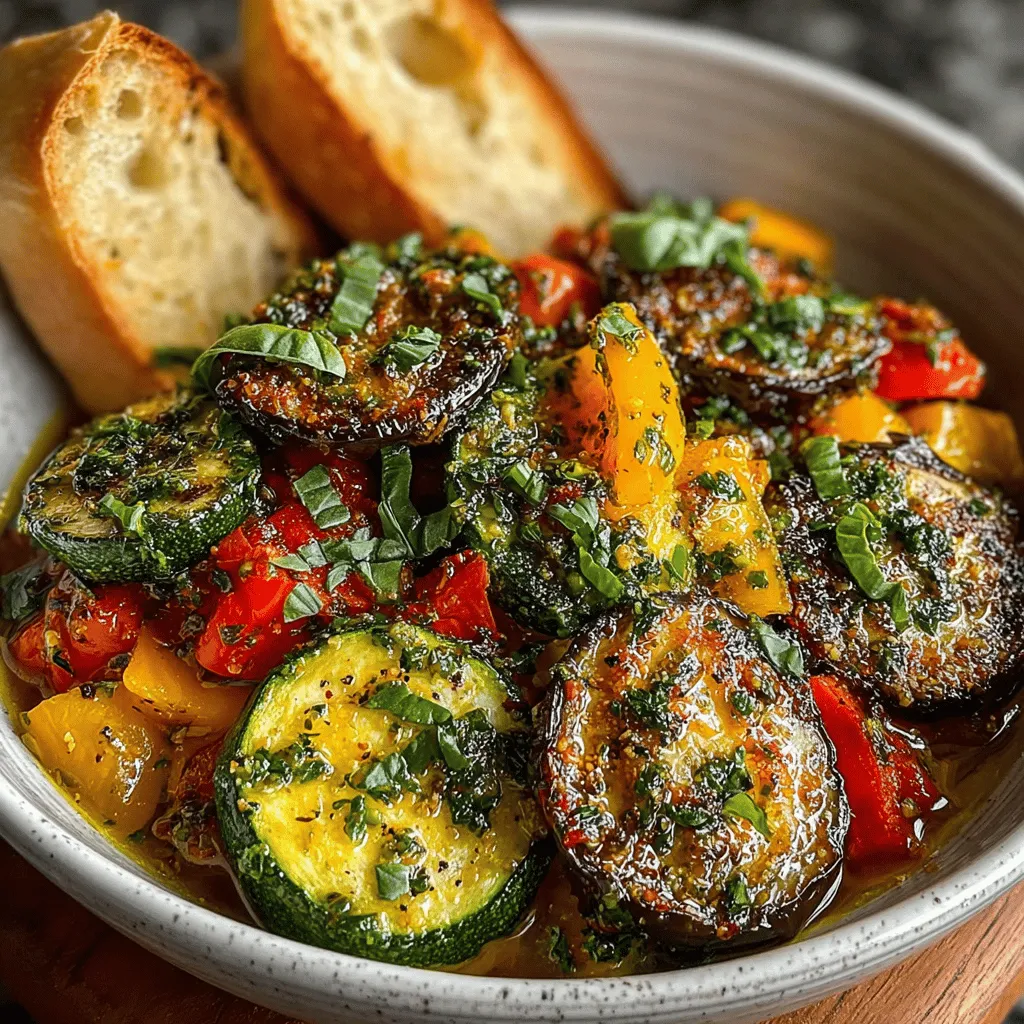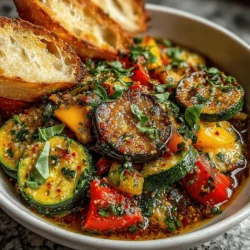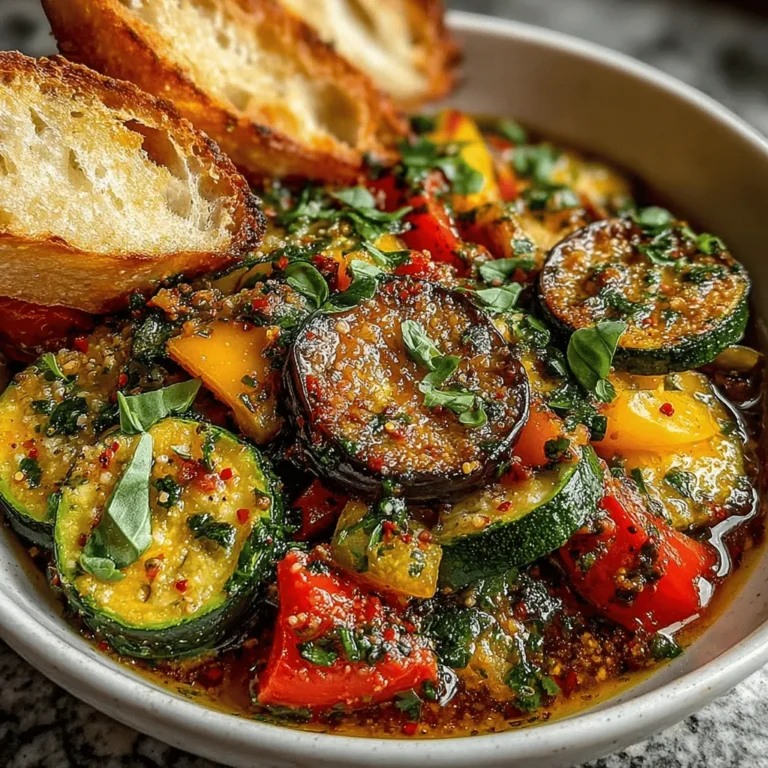Ratatouille Bliss with Crusty Bread: A Culinary Journey into French Tradition
Ratatouille is a classic French dish that encapsulates the essence of summer through its vibrant medley of vegetables. Known for its rustic appeal and hearty flavor, Ratatouille Bliss with Crusty Bread is a recipe that not only celebrates the bounty of fresh produce but also brings a sense of comfort and satisfaction to the table. This dish, with its colorful array of eggplant, zucchini, bell peppers, onions, and tomatoes, serves as a versatile option suitable for both a main course and a side dish. When paired with crusty bread, it transforms into a wholesome meal that promises to delight the senses and nourish the body.
In this article, we will delve into the rich origins of ratatouille, uncover the health benefits of its key ingredients, and provide you with a step-by-step guide to creating this delightful dish. Whether you’re a seasoned chef or a novice cook, this recipe is designed to be accessible, ensuring that you can recreate this French classic in your own kitchen.
The Origins of Ratatouille
To truly appreciate the beauty of ratatouille, one must understand its cultural significance. This traditional Provençal dish traces its roots back to Nice, France, where it emerged as a humble peasant meal crafted from leftover vegetables. The term “ratatouille” itself comes from the French word “touiller,” meaning to stir, which reflects the dish’s simple preparation method. Originally, ratatouille was a way to utilize excess produce during the summer months, embodying the philosophy of “waste not, want not.”
As time passed, ratatouille evolved from its rustic beginnings into a cherished symbol of French cuisine, celebrated for its emphasis on fresh, seasonal ingredients and vibrant flavors. It showcases the culinary prowess of the Provençal region, where sun-kissed vegetables grow abundantly. Today, ratatouille is recognized worldwide for its health benefits, versatility, and the warmth it brings to family gatherings and festive occasions alike.
Exploring the Ingredients
At the heart of Ratatouille Bliss lies an array of wholesome ingredients, each contributing unique flavors and nutritional benefits to the dish. Understanding these components not only enhances the cooking experience but also allows you to appreciate the dish’s healthful qualities.
The Role of Eggplant in Ratatouille
Eggplant, often regarded as a star ingredient in ratatouille, brings a rich, meaty texture to the dish. Nutritionally, eggplant is a powerhouse, packed with dietary fiber and antioxidants, which can aid in digestion and combat oxidative stress. Its unique ability to absorb flavors makes it a crucial component, enhancing the overall taste of the ratatouille.
The Versatility of Zucchini
Zucchini is another essential element of ratatouille, known for its low-calorie and high-water content. This vegetable not only adds a subtle sweetness and a pleasing texture but also serves as a canvas, soaking up the robust flavors of the accompanying ingredients. Its versatility allows it to shine in various culinary applications, making it a staple in many kitchens.
The Importance of Bell Peppers
Bell peppers bring a splash of color to the ratatouille, with their vibrant hues ranging from green to red, yellow, and orange. Beyond their visual appeal, these peppers offer an array of nutritional benefits, including vitamins A and C. Their natural sweetness and crunch provide a delightful contrast to the softer vegetables, enhancing the overall flavor profile of the dish.
The Flavor Foundations: Onions and Garlic
No ratatouille would be complete without the aromatic foundations of onions and garlic. These ingredients form the base of many savory dishes, infusing the ratatouille with depth and complexity. Onions contribute natural sweetness as they caramelize, while garlic adds a pungent, savory note that elevates the dish. Both ingredients are also known for their health benefits, including anti-inflammatory properties and immune-boosting abilities.
The Heart of the Dish: Tomatoes
Tomatoes are the heart and soul of ratatouille, providing acidity and sweetness that balances the flavors of the other ingredients. You can choose between fresh or canned tomatoes, depending on the seasonality and availability. Fresh tomatoes lend a brightness to the dish, while canned tomatoes offer convenience and a rich, concentrated flavor. Regardless of your choice, tomatoes play a crucial role in achieving the perfect balance of taste.
Herbs and Seasonings: Thyme, Basil, and Balsamic Vinegar
To enhance the flavors of ratatouille, fresh herbs such as thyme and basil are indispensable. Thyme brings an earthy aroma, while basil adds a fragrant sweetness that complements the vegetables beautifully. The choice between fresh and dried herbs can impact the dish’s overall flavor, with fresh herbs often providing a more vibrant taste. A drizzle of balsamic vinegar at the end of cooking adds a tangy complexity that ties all the flavors together, making each bite a delightful experience.
Step-by-Step Instructions to Prepare Ratatouille
With a deeper understanding of the origins and ingredients of ratatouille, you are now ready to embark on the culinary journey of preparing this delightful dish. Follow these step-by-step instructions to ensure a successful ratatouille experience.
Preparation of Vegetables
The first step in preparing ratatouille is to gather all your vegetables and ensure they are washed thoroughly. Uniform cutting is crucial for even cooking; aim for bite-sized pieces that will cook at the same rate. Start with the eggplant—slice it into cubes, sprinkle with salt, and let it sit for about 30 minutes. This process helps draw out excess moisture and bitterness, ensuring a better texture once cooked.
Next, chop the zucchini, bell peppers, and onions. For the zucchini, it’s best to slice it into half-moons or rounds, while bell peppers should be cut into strips or cubes, depending on your preference. Finally, dice the onions into small pieces to facilitate quick cooking.
Sautéing Aromatics for Depth of Flavor
Once your vegetables are prepped, the next step is to sauté the aromatics. Heat a generous amount of olive oil in a large skillet or Dutch oven over medium heat. Begin by adding the onions, allowing them to soften and turn translucent, which typically takes about 5 minutes. Next, add minced garlic and sauté for an additional 1-2 minutes, stirring frequently to prevent burning. This technique builds a flavorful base that will enhance the overall taste of your ratatouille.
At this point, you can start adding the rest of the vegetables to the skillet. Begin with the eggplant, followed by bell peppers, zucchini, and finally, the tomatoes. Stir everything together, ensuring that each vegetable is coated in the aromatic oil. Adjust the heat to medium-low and allow the vegetables to cook down for about 20-30 minutes, stirring occasionally. This slow-cooking process allows the flavors to meld beautifully, resulting in a rich and savory ratatouille.
This introduction sets the stage for an engaging exploration of ratatouille, highlighting its rich history, vibrant ingredients, and the initial steps of preparation. As you continue your culinary journey, you will discover the joy of creating this classic dish that brings together the best of summer’s bounty.

Incorporating Eggplant for Texture
Eggplant is a quintessential ingredient in ratatouille, providing a meaty texture and absorbing the rich flavors of the dish. However, to ensure that your eggplant enhances rather than detracts from your ratatouille, it’s essential to prepare it correctly.
Tips for Avoiding Bitterness in Eggplant
Eggplants can sometimes have a bitter taste, especially if they are not properly prepared. Here are some effective tips to avoid bitterness:
– Choose Fresh Eggplants: Opt for younger, smaller eggplants, which tend to be less bitter. Look for firm, glossy skins without blemishes.
– Salting: Salting is a traditional method to draw out moisture and bitterness. Slice your eggplant into the desired shape and sprinkle it with salt. Allow it to sit for about 30 minutes, then rinse off the salt and pat it dry. This process helps to remove any bitterness while also improving the texture.
– Cooking Method: Choose cooking methods that reduce the bitterness, such as roasting or grilling. These methods caramelize the natural sugars in the eggplant, enhancing its flavor.
The Significance of Salting Eggplant
Salting eggplant serves not only to draw out bitterness but also to improve its ability to absorb flavors from the surrounding ingredients. When you salt the eggplant, it releases excess moisture, allowing it to become more receptive to the olive oil and spices during cooking. This results in a deliciously tender and flavorful addition to your ratatouille.
Building Layers of Flavor with Other Vegetables
Ratatouille is about more than just eggplant; it’s a harmonious blend of various vegetables that contribute to its aromatic profile and rich taste. Key vegetables include zucchini, bell peppers, and tomatoes, each adding its unique flavor and texture.
Cooking Techniques for Zucchini and Bell Peppers
– Zucchini: Cut the zucchini into uniform pieces to ensure even cooking. Sauté them in olive oil until they are tender but still have a slight crunch, which helps to maintain a balanced texture in the finished dish.
– Bell Peppers: For bell peppers, consider roasting them beforehand to enhance their sweetness. Cut them into strips or cubes and roast them at high heat until they blister and caramelize. This adds a smoky depth to the dish that complements the other vegetables beautifully.
Importance of Timing for Texture Balance
Timing is crucial when layering vegetables in ratatouille. Start with the eggplant as it takes the longest to cook. Once it has softened, add the zucchini and bell peppers, giving each vegetable enough time to retain its integrity while melding flavors. The goal is to achieve a delightful medley of soft yet distinct pieces, ensuring that every forkful offers a burst of flavor and texture.
Finishing Touches: Tomatoes and Herbs
As you near the final stages of cooking your ratatouille, the finishing touches of tomatoes and fresh herbs will elevate the dish.
Simmering for the Perfect Consistency
Once your vegetables are well-cooked, it’s time to add the tomatoes. Use ripe, seasonal tomatoes for the best flavor. You can chop them roughly or use crushed tomatoes for a smoother consistency. Allow the mixture to simmer gently, letting the flavors meld together. The simmering process will also thicken the dish, creating a rich sauce that clings to the vegetables.
Adjusting Seasoning: The Art of Balancing Flavors
Taste your ratatouille as it simmers, adjusting the seasoning as needed. A pinch of salt, a crack of black pepper, or a sprinkle of dried herbs like thyme or oregano can enhance the overall flavor profile. Don’t forget to add fresh basil or parsley at the end of cooking to provide a burst of freshness.
Adding Balsamic Vinegar for Complexity
While traditional ratatouille doesn’t typically include balsamic vinegar, adding it can introduce a delightful complexity to the dish.
Optional Ingredient: When and How to Use
If you choose to include balsamic vinegar, add it towards the end of cooking. Start with a tablespoon and taste before adding more. The sweet and tangy notes of balsamic vinegar can complement the natural sweetness of the vegetables, providing a beautiful contrast.
The Impact of Acidity on the Dish
Acidity plays a crucial role in balancing the flavors in ratatouille. The addition of balsamic vinegar not only enhances the overall taste but also brightens the dish, making it more vibrant. It can elevate the ratatouille from a simple vegetable dish to a flavorful explosion on your palate.
Preparing and Serving Crusty Bread
No ratatouille is complete without a side of crusty bread to soak up the delicious sauce. The right bread can elevate your dining experience.
Choosing the Right Bread: Baguette vs. Artisan Loaf
When selecting bread to accompany your ratatouille, both a classic French baguette and an artisan sourdough loaf are excellent choices. A baguette offers a traditional French flair, with its crispy crust and soft interior, perfect for dipping. On the other hand, an artisan loaf can add a rustic charm, with complex flavors and textures that complement the dish beautifully.
Toasting Techniques for Optimal Texture
Toasting your bread can enhance its flavor and texture. Slice your chosen bread and brush it lightly with olive oil. Toast it in a preheated oven at 375°F (190°C) for about 10 minutes or until golden brown and crispy. For added flavor, rub a clove of garlic on the warm toasted bread before serving. This simple step will infuse the bread with a delightful aroma that pairs perfectly with your ratatouille.
Serving Suggestions and Pairings
Enhancing the dining experience is not just about the food itself but also how it is presented and paired.
Creative Ways to Serve Ratatouille
– Bowl Presentations vs. Plate Presentations: For a rustic look, serve ratatouille in individual bowls, allowing guests to savor each bite. Alternatively, plating the ratatouille artistically on a large dish can create an impressive centerpiece for family-style dining.
– Garnishing Ideas with Fresh Herbs: Finish your ratatouille with a sprinkle of fresh herbs like basil or parsley. This not only adds a pop of color but also enhances the fresh flavors of the dish.
Wine Pairings to Complement the Dish
Pairing your ratatouille with the right wine can enhance the meal further. Light white wines, such as Sauvignon Blanc or Pinot Grigio, can complement the dish’s flavors beautifully, providing a refreshing contrast. If you prefer red wine, a light-bodied Pinot Noir can also work well.
For those seeking non-alcoholic options, consider sparkling water with a splash of lemon or a non-alcoholic rosé to keep the meal light and refreshing.
The Nutritional Benefits of Ratatouille
Ratatouille isn’t just a feast for the senses; it’s also a highly nutritious dish packed with health benefits.
Low-Calorie and Nutrient-Dense
The primary components of ratatouille are vegetables, making it a low-calorie, nutrient-dense meal. Incorporating a variety of vegetables ensures a wealth of vitamins and minerals, contributing to a balanced diet. This plant-based meal is perfect for anyone looking to reduce calorie intake while still enjoying a fulfilling dish.
Rich in Vitamins and Antioxidants
Key ingredients in ratatouille, such as eggplant, zucchini, and tomatoes, are rich in vitamins C and A, potassium, and fiber. These nutrients support overall health, including immune function, skin health, and digestive health. Additionally, the antioxidants found in these vegetables help combat oxidative stress, contributing to long-term well-being.
Conclusion
Ratatouille Bliss with Crusty Bread is more than just a meal; it’s a celebration of fresh ingredients and culinary heritage. This dish not only nourishes the body but also warms the heart, making it a perfect choice for family dinners, gatherings, or a cozy night in. By embracing the simplicity and flavor of this classic recipe, you can enjoy the essence of Mediterranean cuisine right in your home. Whether you are a seasoned chef or a beginner, this ratatouille recipe invites you to create and savor a delightful dish that honors the richness of seasonal vegetables.
Prepare to enjoy a beautiful blend of flavors, colors, and textures that will not only delight your palate but also promote a healthy lifestyle. So gather your ingredients, fire up your stove, and allow the aromas of your homemade ratatouille to fill your kitchen, creating a culinary memory that you and your loved ones will cherish.


